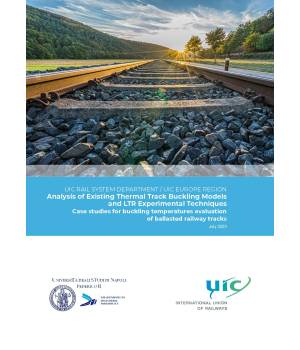
Analysis of Existing Thermal Track Buckling Models and LTR Experimental Techniques - Case studies for buckling temperatures evaluation of ballasted railway tracks
In this report, a sensitivity analysis carried out with some thermal track buckling models currently used by the members of the UIC technical group StableTrack and described in the framework of WP1 is presented. In detail, the buckling models considered for the comparative study are:
1. Meier +,
2. CWERRI + CW Safe – reference calculation program for UIC Leaflet 720 [1],
3. GP Pucillo – RFI,
4. Prud’homme, Janin.
The input parameters are summarized in Section 1, and for concrete sleepers they coincide with the data set included in the ÖBB regulation (Stabilitätsberechnung von Gleisen), see Table 5.
For wooden sleepers, instead, a different value from that reported in the ÖBB document was considered in terms of lateral resistance per meter of track of the sleeper-ballast system, namely 8.8 N/mm in place of 7.0 N/mm, as the CWERRI software does not allow to perform calculations with sleeper-ballast lateral resistance values below a certain threshold.
For the other models, the set of input parameters were calculated consistently (see Table 1,Table 4, Table 6 and Table 7).
It is important to specify that, to carry out the calculations under the same conditions with all the models, the possible presence of the peak lateral resistance was not considered, i.e. no compaction effect on the sleeper-ballast lateral resistance curve (see Figure 1), as this characteristic is an input parameter only in the GP Pucillo-RFI model and in CWERRI software.
Finally, the results of the calculations are exposed in tabular and graphical format in Section 2.
| Auteur | UIC |
| ISBN | 978-2-7461-3299-3 |
| Pages | 18 |
Fiche technique
- Langage
- Anglais
- Format
- Téléchargeable
- Edition
- Ed. no.1
- Date d'édition
- 01/07/2023
- Date de publication
- 29/09/2023
- Nombre de pages
- 18
- sku
- 5-23016E-PDF
- Reference
- 5-23016E
 Préférences sur les cookies
Préférences sur les cookies

